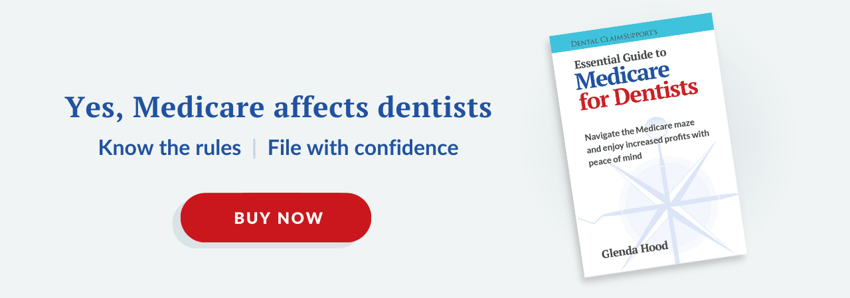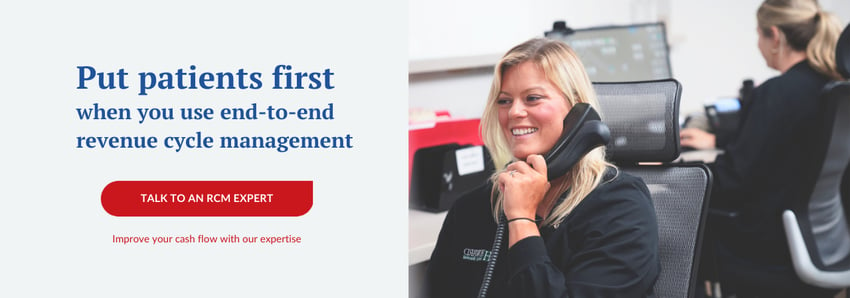When it comes to filing medical claims as a dental professional, confusion is inevitable. Especially if you don’t have a lot of experience handling medical claims. Understanding the fundamental differences between medical and dental claims can help your team avoid denials, reduce re-work, and collect more payments.
Dental ClaimSupport ensures dental teams receive both dental and medical claim reimbursement. A common question we’ve seen is how to bill medical insurance for dental procedures. Knowing how to submit a dental claim to medical insurance is crucial to collect what you’ve earned.
In this article, we will take a closer look at medical billing for dental procedures. See the differences between a dental claim and a medical claim. We will cover the different information needed on each as well as how they are filed. This information will help your team know what it takes to file accurate claims for quicker reimbursement from medical claims.
Is the information needed on a medical claim different than a dental claim?
The short answer is yes. Medical and dental claims require distinctly different forms of claim submission. They also require totally different information and procedure coding.
If you get this information wrong, you won’t be properly reimbursed and your collections will go down. That’s why we’re here to help you understand the big differences between what is required for a medical versus a dental claim.
In these comparisons, we’re going to assume you already know that you need to include the patient information and their insurance group ID number.
Let’s dive in.
Information needed on a medical claim
First off - medical claims require a different claim form than dental claims.
Many practice management software programs will have the form format available. However printing them may be difficult as there are very strict rules about the font size, form, and capitalizations that must happen.
Some of the information required on a medical claim form:
- Diagnosis pointer
- Place of service
- CPT and/or HCPCS National codes
- ICD-10-CM diagnoses codes
- Modifiers - In your software, modifiers are listed to the right of the primary procedure code under the column marked “modifier.”
Note that some third-party payers may require the original red and white CMS 1500 form. The original red and white form has information on the front and back of the form. An original form may be purchased from office supply companies or your local dental supply company.
Medical claim forms can look intimidating, but the more educated you are on medical billing as a dental professional, the easier it gets.
Read about common errors dentists face when dealing with medical claims in our Learning Center.
Information needed on a dental claim
Let’s cover what information you should include on a dental claim so that you can compare it with medical claims.
A dental claim will need the following information:
- CDT code
- The fee
- Provider information
- Patient information
- Subscriber information
- Clinical notes
- Attachment information
- Initial placement or date of initial placement
You can visit the ADA website to look further into what information is required on a dental claim.

Are medical and dental claims filed differently?
Here’s the great thing: both dental AND medical claims can be filed electronically. As of 2021, the current medical claim form, which should always be used, is the CMS 1500 (02-12).
Most software programs will allow you to set up a medical plan that uses the CMS or HCFA 1500 format.
While some insurance companies may continue to accept a handwritten medical claim, we don’t recommend it. These handwritten forms are scanned into the payer’s software and read by the software, so a claim denial is highly likely. And you want to do everything you can to avoid denials.
Are medical and dental claims reimbursed at different rates?
Yep! Medical claims typically take longer to reimburse dental practices. Plus, medical plans typically have higher deductibles. Many medical plans require referrals as well, so you’ll need to verify the patient’s coverage. Ideally, this is completed during your insurance verification process - before the day of their treatment.
There’s also a little bit more paperwork involved before the patient’s service if you’ll be filing a medical claim. The practice will need to contact the insurance company and know exactly what information they need. When in doubt, ask! The insurance company should tell you everything you need to know.
Ready to learn when to file a medical claim versus a dental claim?
Knowing how to bill medical insurance for dental procedures is certainly different from filing a dental claim.
To help you gain valuable skills, get training (and CE credit) in this course: ICD-10-CM - Applying medical diagnostic codes to the dental claim. You’ll be able to help your team know how to submit a dental claim to medical insurance.
Dental ClaimSupport has a number of training courses available in dental medical billing. And to ensure fast payments, we also offer dental insurance claims processing that includes medical billing for dental procedures. See pricing and details.
Even knowing when to file a medical claim versus a dental at your practice can be confusing, but it doesn’t have to be. Visit our Learning Center to read, “3 times a dentist should file a medical claim versus a dental claim.”
Related Posts
Dental revenue resources from Dental Cashflow Solutions (formerly Dental Claim Support)




